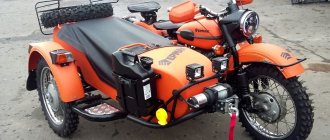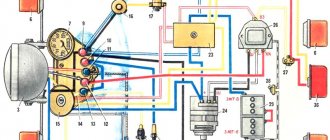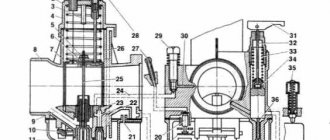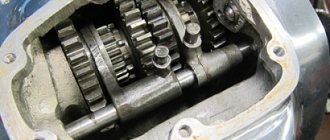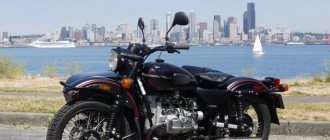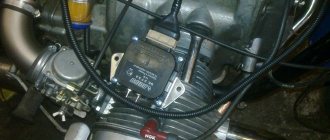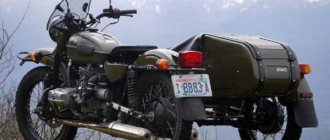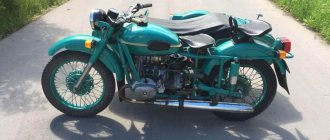All-wheel drive motorcycles are nothing new or unusual. They were created quite a long time ago, and similar vehicles were used mainly to participate in rally-type motorcycle racing. First of all, this is due to the fact that such models cope much better with turns at high speed.
However, unlike four-wheel drive vehicles, a four-wheel drive motorcycle does not have a full-fledged driven front wheel. On the most common models of this type from the Yamaha and KTM brands, only 20% of the power is transmitted to the front wheel. Christini's company was able to create a bike with 50 percent of the power transferred to the front wheel, but this greatly increased the weight of the vehicle. What can domestic models oppose to all this? We will talk now about all the advantages and disadvantages of the Ural all-wheel drive motorcycle .
When did the first all-wheel drive moped appear?
The model was first demonstrated in 1924 in Britain. For many years this was the only copy. Only almost 3 decades later the famous Rokon bike was made. Its operating principle was based on transmitting torque to the front wheel using two chains.
Despite the fact that there was no suspension, the motorcycle felt great on difficult sections of the road. The weight of such a vehicle did not even reach 100 kg. This motorbike is widely popular in our time .
Video review of the Ural motorcycle with a sidecar drive:
History of the development of the model design
The Ural M 62 motorcycle, 650 cm cubed, was created in 1961 by the Irbit Motorcycle Plant on the basis of the M 72M motorcycle.
After the Irbit plant created a new forced overhead valve engine and began installing it on the M 72 motorcycle, a transitional model appeared - the M 61.
The M62 motorcycle is a modernized model of the M 61 and differs from it in the design of the power transmission, chassis and ignition system devices. The main technical parameters of the engine remained unchanged.
The engines are overhead valve and were manufactured on the basis of the M 72M engine, therefore only their distinctive features are described in comparison with the design of the M 72M engine.
The crank with connecting rods is an integral unit, which differs from the corresponding unit of the M 72M engine in the length of the connecting rod and the distance from the axis of the axle to the axis of the crank pin.
A second oil scraper ring is installed on the lower part of the piston skirt.
The cylinders are interchangeable and in the upper part have four holes for the head mounting studs and two holes into which the pusher rod tubes are pressed.
To drain oil from the valve box into the crankcase, there is a tube passing through the cylinder ribs.
Diagram of the gas distribution mechanism of the M 62 engine.
The gas distribution mechanism of the described engine is an overhead valve mechanism, which is its fundamental difference from the M 72M engine.
The valve disc diameter is 35mm, the stem diameter is 7.5mm and the overall valve length is 91mm. The valves move in guides pressed into the body of the cylinder head. The gap between the bushing and the valve stem is 0.05-0.1 mm.
The camshaft has four camshafts, which differ from the cams of the M72M engine shaft in their shape and location, which makes the camshafts not interchangeable.
Tips with a hemispherical recess are pressed into the body of the pushers.
The thermal gap (0.1 mm) between the valve stem and the rocker arm is adjusted with the valve box cover removed.
Lubrication system
Valves and rocker arms are splash lubricated. Through holes located at the end of the pushrod guide bushings and the rod casing, oil enters the cylinder heads and is sprayed there by the valve springs.
Supply system
The M 61 engine has two K-52 carburetors, and the M 62 engine has two K-38 carburetors. Two K-37 carburetors can be installed on the M61 motorcycle engine.
Return to contents — ↑
What about the all-wheel drive Ural?
In principle, such a vehicle has never been officially released. Thus, it will not be possible to purchase a production model. However, one Russian craftsman managed to independently create a Ural with a wheelchair drive, which copes well with difficult sections of the road. A radiator from a VAZ 2106, as well as two additional electric fans, are mounted on such a vehicle. You will also need a 63 amp battery and a homemade transmission mechanism.
It is worth saying that this version of the Ural wheelchair drive is the most universal and allows you to achieve excellent cross-country ability and reliability. As a result, many began to inherit and copy such a creation, so that now you can see a fairly large number of similar vehicles.
Unfortunately, manufacturers do not always listen to the wishes of customers, so the Ural motorcycle with a sidecar drive has not yet entered mass production . Well, perhaps in a few years they will begin to produce it en masse, but for now we should be content with homemade models.
Technical characteristics of the motorcycle Ural M 62
Total information
Motorcycle type - With sidecar Base, mm - 1435 Ground clearance, mm - 125 Track, mm - 1100 Dimensions, mm: Length - 2420 Width - 1650 Height (by ignition key) - 1000 Motorcycle weight, kg: dry - 340 working - 366 Fuel consumption on the highway, l/100 km -6.0 Fuel reserve on the highway, km - 300 Highest speed, km/h - 100 Capacity (oil), l: engine crankcase - 2.0 Gearbox crankcase - 0.8 reverse gear housing - 0.150 air cleaner - 0.2 Fuel tank capacity, l - 22
Engine
Engine type - Four-stroke two-cylinder Brand - M - 62 Cylinder diameter, mm - 78 Piston stroke, mm -68 Displacement, cm cubed - 649 Compression ratio - 6.2 ± 0.2 Maximum power, l. With. — 28 Maximum torque, kg m — 4.5 Block head material — aluminum alloy Head gasket — Asbestos metal 0.6 mm Piston material — aluminum alloy Valve distribution phases (by crank angle), deg.: beginning of intake to c. m.t. - 57 end of intake after n. m.t. -77 beginning of production BC m. t. - 97 end of release after century. m.t. - 37 Carburetor - Two K - 38
Power train or transmission
Main gear ratio - 4.62 Clutch - Dry double-disc in the engine flywheel Number of disks: driving - 3 driven - 2 Number of springs - 6
Transmission
Type - Four-speed two-way Gear ratios: in first gear - 3.6 in second gear - 2.286 in third gear - 1.7 in fourth gear - 1.3 Total gear ratio: in first gear - 16.65 in second gear - 10, 56 in third gear - 7.85 in fourth gear - 6.01
Tires
Size, in inches - 3.75-19 Pressure, kg/cm squared: front wheel - 1.8 rear wheel - 2.2 stroller wheels - 2.0 spare wheel - 2.2
Ignition Electrical equipment
Type - battery magneto Ignition coil brand - B - 201 Battery - 3 M T - 14 Generator - G - 402 Regulator relay - R R - 302 Signal - S - 23 Headlight - F G - 116
Return to contents — ↑
Advantages and disadvantages of the vehicle
Among the main reasons why the Ural with a leading sidecar is very popular are:
- excellent cross-country ability (the probability of getting stuck anywhere is almost zero);
- good load capacity;
- improved management;
- smoother and softer dynamics.
But the Ural all-wheel drive motorcycle also has some disadvantages. First of all, there is a more complex chassis design. In addition, there is no way to detach the stroller. At the same time, there are clearly more advantages. Especially for those who love driving on difficult roads.
Differential Ural drive
As far as I understand, there are few such Ural differential drives on hand. I know two, maximum three copies. It is possible that their design and equipment will be of interest to lovers of powered wheelchairs. If anyone has anything to add on the matter, you are welcome.
So, let's start disassembling...
First, remove the stroller cardan fork. It contains an oil seal: 62-06162-10, its dimensions are 24.4x36.5x6.9. As you can see, it's pretty worn out.
Unscrew the six fastening nuts and disconnect the cover from the axle housing
View of the bridge housing
And a view of the axle housing cover. Pay attention to the spacer sleeve.
On this side there was a second spacer bushing. It fell out when removing the crankcase cover.
The gear (epicyclic?) rotates on two needle bearings. Needles 3x15.8. It's a pity that the surface of the gear where the needles were was slightly rusted. I'll try to polish it a little.
Actually, in this gear, under the thrust ring, there is another oil seal 62-06162-10, completely broken.
In the crankcase cover, remove the retaining ring and the bronze spacer ring and pull out the diff housing.
Next, you can remove the sidecar drive gear from the cover, which rotates in the crankcase cover in a large bearing number 113 (analogue 6013), dimensions 65x100x18
Inside the stroller drive gear there is a double-row angular contact bearing (I couldn’t find the domestic number) with dimensions 20x47x20.6 (imported analogue 3204). The rear wheel axle rotates in it.
This bearing turned out to be in good condition; it could not be knocked out.
Next, remove the locking cap from the crankcase cover
and unscrew a large nut with a 55x80x10 oil seal installed in it and an o-ring
After this, you can remove the 113th bearing from the crankcase cover
The GP driven gear sits on a needle bearing with needle sizes 5x12
The drive gear is installed in exactly the same way as on the single-drive version: needle bearing 874901, size 13x32x17/20 and double-row angular contact bearing 3086304 L, size 20x52x22.22 (analogue 3304) - it was broken.
GP in this case is “eight”.
The axis of the stroller wheel rotates in two radial bearings: 6206-2RS1 (30x62x16) and 6207-2RS1 (35x72x17), as in modern “gyrapes”. Cardan crosspieces for driving strollers can be taken from Zhiguli ones.
Bearings and seals have been ordered. I will try to photograph the assembly process, especially if there are any nuances.
Another domestic model
Dnepr-16 is another Soviet bike with a sidecar. The model stands out thanks to the rubberized stroller springs and a load capacity of 200 kg. Such a vehicle will be an excellent option for leisure and work.
You may also be interested in: Military motorcycles in service in different countries
A short summary
So, all-wheel drive motorcycles are indispensable vehicles for those who often need to travel on difficult roads. They are distinguished by increased maneuverability and reliability. Among our models, the Ural with all-wheel drive stands out here .
Such a vehicle can easily overcome almost any section of the road. However, the bike did not go into mass production, so you should either buy it on the secondary market or upgrade it yourself.
Cool video test drive of an all-wheel drive Ural motorcycle:
